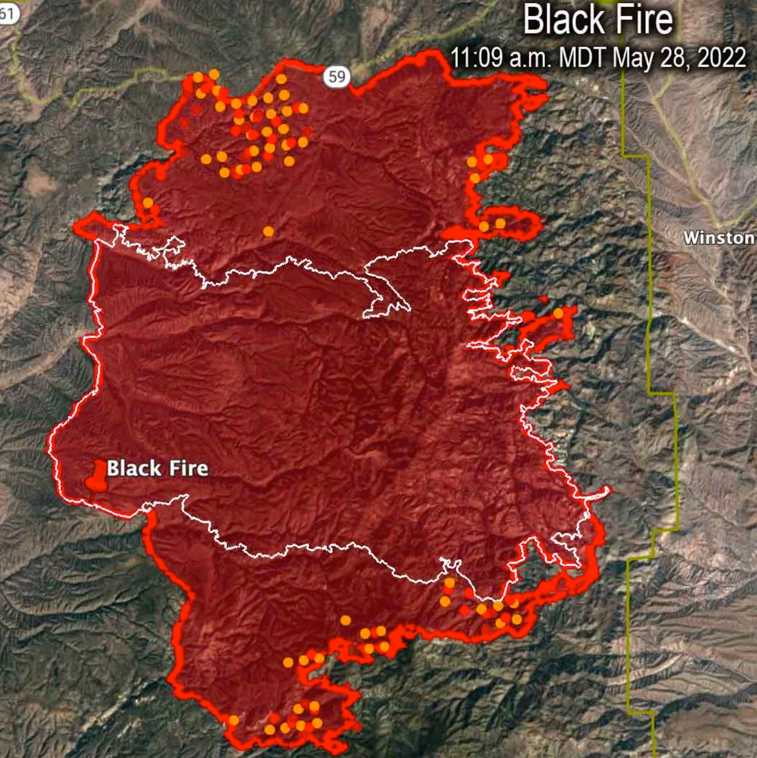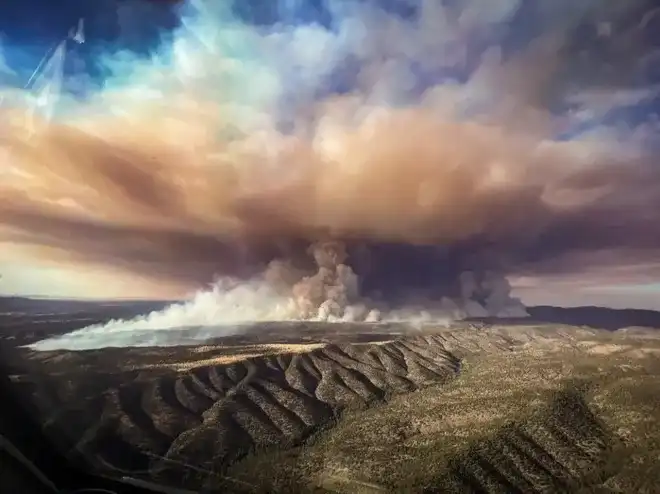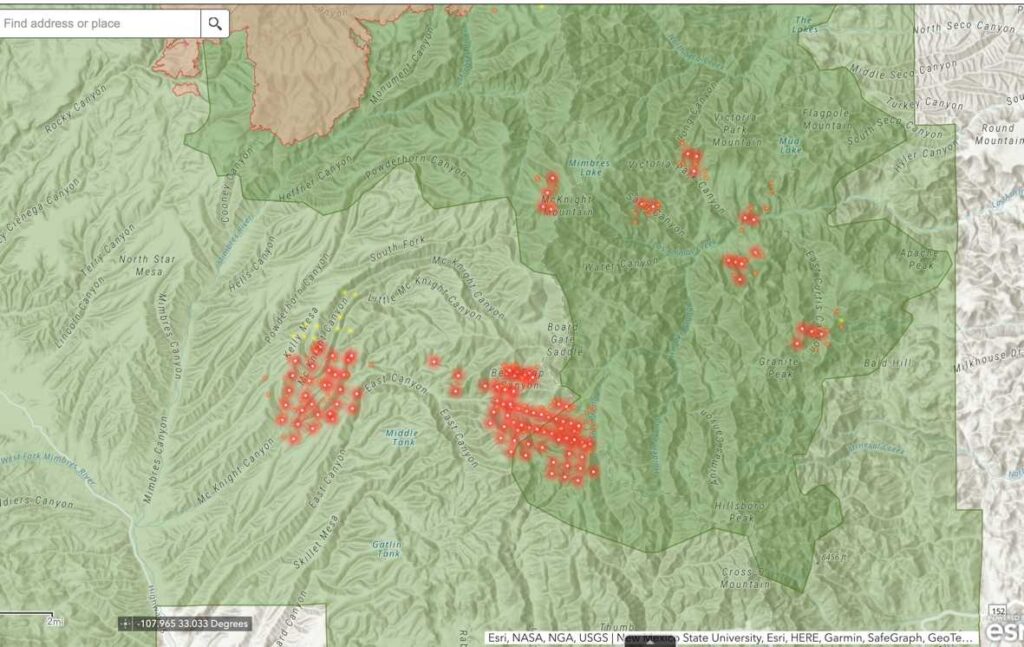REVISITING FRANK CARROLL, WHO COINED THE PHRASE “BLOWTORCH FORESTRY” TO DESCRIBE THE FOREST SERVICE’S PREFERENCE FOR WHAT IT EUPHEMISTICALLY CALLS “MANAGED FIRE.”
Editor’s note: When we interviewed Frank Carroll in April 2020, he coined the phrase “blowtorch forestry” to describe the Forest Service’s preference for what it euphemistically calls “managed fire.”Managed fire – very large deliberately set burns - as opposed to thinning and prescribed fire, a one-two combination that has been safely and successfully used for decades by state and private landowners and Indian tribes across the nation.We circled back to Frank last week to ask him if anything in the Forest Service world of blowtorch forestry has changed. “No, nothing,“ he replied. “Deferred fire suppression and the resulting huge managed wildfires have grown much worse.”Now, the interviewEvergreen: Deferred fire suppression? What’s that, Frank?Carroll: “Deferred” meaning Forest Service does intend to put the fire out sometime, somewhere down the road. But first they want to “manage the fire” for “ecosystem benefit.” So we see these big fires on the nightly news for weeks or months on end. It’s no wonder the public is confused and angry about what the Forest Service is actually doing and not doing.Evergreen: Frank, when we last visited with you two years ago, you expressed great concern for the Forest Service’s seeming preference for using deferred fire suppression - managed fire - as their primary means of reducing the fire risk in dying forests rather than actual mechanical thinning – which would also reduce wildfire risk with none of the damage fires do. Has anything changed since then that could lead us back to thinning and away from big wildfires?Carroll: No, nothing. Deferred fire suppression is more prevalent than ever before. The Forest Service is doubling down on a very destructive strategy.
Evergreen: New Mexico being the focal point of this doubling down.
Carroll: Yes. The three largest fires in New Mexico history are massive firing operations deliberately lit by remotely operated drones – Ukraine-style air strikes. A firing op on the Black Fire right now involves from 130,000 to 250,000 acres lit. They’re using the state highways as fire lines. The Laguna Fire in 1970, the biggest fire to that time, was only 100,000 acres.

Gila National Forest. Yellow dots pinpoint drone ignitions. Ukraine-style bombing says Frank Carroll
Evergreen: My god, this is just nuts. Are there alternatives our readers can reference for comparison.
Carroll: Siskiyou National Forest Supervisor, Merv George, has demonstrated that these fires can be extinguished quickly – as can most wildfires – if you jump on them when they’re small. Most Forest Supervisors are no longer aware of why you’d want to put out a fire. They do so much good, right?
Evergreen: Blowtorch forestry.
Carroll: Blowtorch forestry.
Evergreen: Yet the Forest Service insists initial attack is as aggressive as possible.
Carroll: Having worked for the Forest Service for more than 30 years, I assure you the agency is capable of convincing itself that what it is doing is the best it can do.
Evergreen: So, they’re delusional?
Carroll: I’m not sure there is a one-word description for what we are witnessing. Serial litigators hired by environmental groups have all but stopped meaningful forest management. Forest Service officials at the highest levels have concluded that fire management is the last bastion they hold where they don’t have to ask anyone’s permission.
Evergreen: Playing with fire.
Carroll: In a manner of speaking, yes.
Evergreen: What the agency clinically calls “using fire for resource benefit.”
Carroll: Yes. Honesty, integrity and grit were commonly held values in the Forest Service for 100 years. These qualities have been sorely tested by political issues and events that bring us to where we are today.
Evergreen: And where do you think we are today?
Carroll: You read my opinion piece in the Santa Fe New Mexican and my subsequent letter to Chief Moore?
Evergreen: We did. What you describe looks to us like an enormous gamble with public safety.
Carroll: It is. Chief Moore crossed his fingers when he told us he was “pausing prescribed burning for 90 days.” He then fielded thousands of firefighters and deployed millions of dollars in equipment and support to purposefully burn vast stretches of the western states.
Evergreen: Because he doesn’t believe he has to answer to anyone.
Carroll: That’s correct.
Evergreen: In your op-ed you lay out a legal basis that New Mexico residents damaged by the Hermit’s Peak-Calf Canyon Fire can use to sue the sox off the federal government. To this I should add that the fire is about 70 percent contained, that it was started as a prescribed fire that escaped its handlers and it has now burned about 320,000 acres.
Carroll: And New Mexico Governor, Michelle Lujan Grisham, is in a towering rage about it and has said there will be no more prescribed burns in her state.
Evergreen: Well, as long as we’re adding things, I should add that Governor Grisham is a Democrat and a lawyer and that she and her husband, Manuel Cordova, were married this past May by another lawyer, Kamala Harris, who just happens to be the Vice President of the United States. Pretty delicious, I’d say.
Carroll: I suspect the Governor has the Vice President’s ear where New Mexico’s wildfires are concerned, but when President Biden visited Las Vegas, New Mexico on June 11 he didn’t say anything that suggests he understands the depth and scope of the Forest Service’s role in the losses people suffered at Mora and Guadalupita.
However, he does deserve credit for saying the government would pay for everything, 100 percent. He will need legislation and a congressionally approved appropriation to get this done. I am hopeful.
Evergreen: The two small communities in the path of Hermit’s Peak bring me to your reference to the Cerro Grande Fire at Los Alamos 22 years ago. That fire burned 235 homes that FEMA rebuilt at federal expense.
You wrote, and I quote, “Environmental justice demands that FEMA do for northern New Mexicans what it did for Los Alamos; speedily act to make people whole, but-for-the-fires. It would be troubling if 235 PhD’s in Los Alamos were treated differently than the children of the First Peoples and the now-indigenous Hispanic peoples.”
Other than some of my own writings, I’ve never seen anyone connect environmental justice to the horrific damage the West’s killing wildfires are causing.
Carroll: It’s time, Jim. It’s time. We need to build a much larger bully pulpit than the one we have – and if we need to build it in federal courtrooms that’s where we should build it.
The Forest Service needs a two to three year time out, not a two month pause. It needs to build informed consent among the governed. The public doesn’t know that these fires are being purposefully lit because it is the only strategy radical environmental groups will accept.
Evergreen: It’s astonishing that the Forest Service is not legally or financially responsible for the harm this newfound worship of the fire gods is causing.
Carroll: The public sees firefighters on lines working their butts off and thinks the Forest Service is riding to the rescue when, in fact, the agency purposefully lit these fires because it has lost the moral high ground to anti-forestry activists. Deferred fire – managed fire – has become the agency’s religion.
Evergreen: What we see here is immoral and unethical. Are we wrong?
Carroll: No you aren’t but let’s understand that fire is important management tool when used properly. But we need to bring the public along with the whole notion of managed fire. Enact laws that authorize the Forest Service to pay for the damages these fires cause. Build informed consent of those affected by this one-way policy that always surprises every American who must confront it as their homes burn.
Evergreen: You reference the Tucker Act in your op-ed. How can it help people whose homes and properties are deliberately burned by the Forest Service?
Carroll: Taking private property for public purposes is called inverse condemnation. When the Forest Service burns private property, either in prescribed fires or in wildfire use fires, they are seizing your property to meet their purposes, either on purpose or accidentally, it’s still a fire trespass.
It owes you for the damage the fire did on your home and land. You have six years in which to file your claim, but if the government loses in court, it must pay for your losses plus attorney and expert witness fees.
Evergreen: You also mention the Federal Tort Claims Act in your op-ed. What does it provide for people whose homes and properties are burned?
Carroll: The Tort Claims Act provides a two-year window for you to file a Standard Form 95 detailing the damages you have suffered. It’s a long tough process. We need legislation that specifically authorizes and appropriates money for damages from managed fires and prescribed fires.
Evergreen: And then there is FEMA, which stepped in at Los Alamos in 2000.
Carroll: FEMA and other state and local agencies can help you with rebuilding. Their services are very limited. FEMA only shows up when an emergency is declared in the State. It’s very frustrating. It’s possible they could, if authorized by legislation and appropriation, rebuild the communities on the Santa Fe National Forest to a condition the day before the fire.
Evergreen: How about the Equal Access to Justice Act? The anti-forestry mob often uses it to allege that the Forest Service has failed to meet the provisions of federal environmental laws. I recall you telling me that you believe managed fire violates the National Environmental Protection Act.
Carroll: Managed fires constitute major federal actions and NEPA says that such actions necessitate an environmental impact statement. The Administrative Procedures Act requires the government to consult with people who will be affected by their actions.
The 2012 Planning Rule requires significant federal actions to be subjected to a rigorous public process. The various substantive Acts like Clean Air and Clean Water also require compliance. The agency is cloaking huge managed wildfires as life-threatening emergencies. Who can argue with that?

Black Fire smoke plume, Gila National Forest, New Mexico, May 16, now 312,000 acres
Evergreen: I have a copy of a blistering one-page letter you wrote to Chief Moore concerning the Black Fire on the Gila National Forest, 304,550 acres of timber and grassland as of Sunday, June 12, and 42 percent contained. You say in this letter that Governor Grisham is “apoplectic.” Have you spoken to her?
Carroll: No, but I have a great picture of her at a Forest Service briefing. You decide if the description fits. It is not an understatement to say that she is in a towering rage. But here I should say that neither Governor Grisham nor I blame firefighters. This isn’t about the Boots on the ground. They’re doing their job as best they can. But they’ve been given the wrong job at the wrong place at the wrong time.
Evergreen: I agree, and I also believe the Forest Service has invested in the wrong aerial firefighting assets. Rapid response is virtually impossible with large aircraft that can’t easily be positioned in rural areas where most fires occur.
Carroll: I agree. Rapid response is key. As you write in the title of your book, First, Put Out the Fire!
Evergreen: Back to the Black Fire for a moment. This fire is under investigation and wasn’t a prescribed burn that got away from its handlers. Right?
Carroll: It’s worse. Chief Moore’s earlier response to the New Mexico fires and the Governor’s anger was to announce that the use of prescribed burns would be paused until August.
Then comes the Black Fire and we see fire crews lighting a Big Box - in essence a huge prescribed burn, possibly 250,000 acres, to meet aspirational natural resource objectives that endanger lives, homes, and property.
And we see this happening after Chief Moore promised there would be no more prescribed burns.
Evergreen: Your anger boils over in one paragraph of this letter that I want to quote verbatim:
“Chief Moore, science is informative, not directive. You are making a huge mistake and maybe that’s okay. See you in the court of public opinion and probably in court as the government continues to spend millions to defend against rightful claims of private property you devastate and continue to devastate this summer.
You willfully violate the Tucker Act, as you are about to do tonight in New Mexico, and you have no authority to help anyone recover. These fires are not driven by climate change. They are driven by your burners. Stop it.”
Seems to us that you’ve thrown down the gauntlet. Have you?
Carroll: I have. It’s time to drive a stake in the heart of the managed fire vampire. We need to do it now or the West will be lost to a massive conversion of beautiful pine forests to brush fields and weed patches that will persist for centuries. Not just our national forests but millions of acres of private land, state land , tribal land and who knows how many homes within designated Wildland Urban Interface communities.

Aldo Leopold Wilderness, Gila National Forest. Deliberately lit by drones will likely burn the entire wilderness .
Evergreen: You and I are cc-d on lots of email correspondence involving Forest Service retirees – including two Evergreen Foundation board members – who are angry about the fact that the agency has ignored their many letters suggesting strategies for reducing wildfire risks and reducing the size, destructive force, and frequency of wildfires.
This group brings well over 1,000 years of experience with fire and its proper use to the table. Why would Forest Service leadership ignore such a wealth of hard-earned knowledge and experience?
Carroll: Today’s Forest Service has no interest in the experiences of yesterday’s Forest Service. Their stories don’t fit today’s narrative. Most retirees are from the era when wildfires were quickly extinguished to protect forest resources from being destroyed by fire.
Today’s narrative is all about fire for resource benefit. Where is the benefit in wildfires as large and destructive as the ones we are seeing in the West today?
I challenge anyone in the Forest Service to tell me what benefits we are going to see over the next 50-100 years that could not be achieved more safely at less cost by the widespread use of thinning and prescribed fire.
Remember, the agency is spending at least $100 million on every large fire. Why not use that money in advance to safely thin and light burn? States do it. Private landowners do it. Indian tribes do it. But not the Forest Service. Why? The environmental benefits are well known and long lasting.
Chief Moore may know this, but it’s almost impossible for him to use the tools developed in 1980 Forest Planning efforts to retool the Forest Service for natural resource management by the widespread application of human solutions, like firewood cutting, logging, thinning, and light burning. He has to do massive paperwork, which he absolutely should do, to use human solutions. Fire is his domain alone and he can and does wield it for any purpose he wants.
Evergreen: Speaking of Chief Moore, why would he pause the use of prescribed fire until August? Is he intending to start burning again in the two hottest months of the year? Why not just pause the entire burn program pending a couple of years of public and congressional review of the whole wildfire mess?
Carroll: Historically, informed public consent was central to the way our national forests were managed. No such consent exists today. The public has no idea what is happening or why. The anti-forestry mob is dictating federal forest policies that suit its beliefs, so we have wildfire replacing science-based forest management, including thinning and the proper use of prescribed fire, and we have the Forest Service complying with their wishes because it’s easier than fighting it out in court.
Evergreen: And you intend to fight it out in court.
Carroll: We are working on many fronts to rein in and redirect Forest Service efforts. This is a huge ship that has been moving in the same general direction for at least 30 years. It will take a long time to steer a course correction.